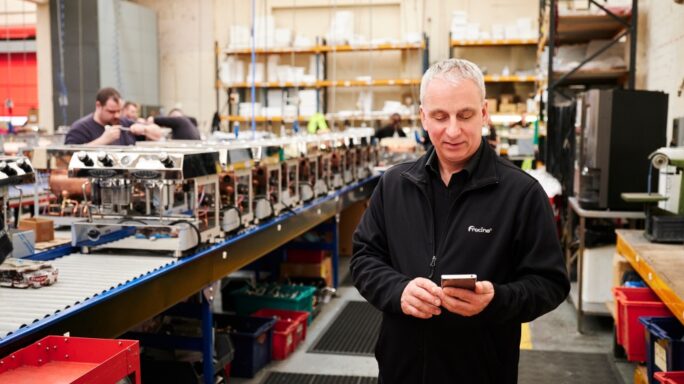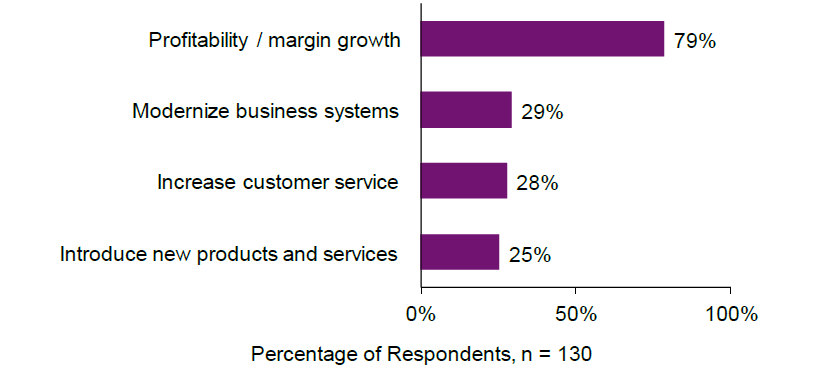Growth & Customers
Industry 4.0: Why you need to invest in it to increase growth

Manufacturers in the UK finished the year positively, with the strongest three months for growth since 2014. Markit/Cips UK Manufacturing Purchasing Managers’ Index figures showed that activity and new orders expanded throughout the past 17 months in the UK, with firms increasing production in response to new orders and the launch of new product lines.
However, this is not the time for your manufacturing business to rest on its laurels. Investment in capacity and machinery is needed to take advantage of expected growth, with many leading manufacturers fast becoming “Industry 4.0” ready.
What is Industry 4.0 and why does it matter to you?
Industrial revolutions are huge, significant events and observers believe we’ve had four of them. The first was initiated by the introduction of the commercial steam engine and the birth of the textile industry. The second was sparked by electricity and mass production. And the third was triggered by the computer after World War 2.
Professor Klaus Schwab, founder and executive chairman of the World Economic Forum, believes we’re well under way with the fourth industrial revolution.
Also known as Industry 4.0, it refers to major innovations in technology that are coming into maturity at the same time, embedded by companies around the world, integrating the virtual and physical worlds to bring forth powerful new ways of working. Examples of this technology include:
Internet of Things
The fusion of physical objects such as software, sensors and electronic items with internet and machine-enabled data collection and transfer. IoT allows real-time communication, initiating physical systems and giving rise to smart cities.
It offers you the opportunity to build digitised and connected supply chains – completely integrated ecosystems that are fully transparent to the contributing marketing, product development, manufacturing, and distribution departments.
Big data and advanced analytics
With the Internet of Things comes a huge amount of data – and the way your business reads and analyses that information is important. In manufacturing, the availability of data from product development, production and testing can add new dimensions to the way you manufacture goods, offering better innovation, marketing and decision making.
Robotics and automation
Robots are already used extensively in the manufacturing world – mechanical arms on assembly arms for example. Industry 4.0 could see the contribution of robots massively increasing, and consider the possibility of building “smart factories” where robots take ownership of manufacturing and bring goods to customers with limited human input, due to computing and communication systems linked with physical systems.
Simulations, 3D printing and augmented reality
Already commonplace today, goods can be virtually modelled and tested, saving time and reducing the materials, efforts and money spent. Through 3D printing, we can see the creation of customised, complex and lightweight designs at remarkable speeds, while augmented reality sees a future where employees can be trained on the job far more effectively than with paper or monitors.
Winning in the age of Industry 4.0 webinar
Watch this webinar to learn how embracing Industry 4.0 technology can power growth and efficiency for your manufacturing firm for years to come.

Why you should be investing in industry 4.0?
Industry 4.0 isn’t a buzzword. In fact, businesses are already putting down investment – and organisations that aren’t are at risk of being left behind.
PwC claims Industry 4.0 will revolutionise industrial production, with businesses generating on average 3.6% per annum cost reductions until 2021, driven by internal improvements and working more closely across value chains.
They also expect to generate 2.9% p.a. in increased revenues by digitising products and services, as well as developing new digital service offerings. Meanwhile, 33% of industrial companies say they’ve already achieved advanced levels of digitisation, and 72% of companies expect to achieve advanced levels of digitisation by 2020.
Consider the top manufacturing goals for a business, according to Aberdeen:

Top manufacturing goals. Source: Aberdeen Group, February 2017
Increased competition is leading a focus on servicing customers, which requires your manufacturing business to explore new ways to deliver products and services – the change in processes and business models that Industry 4.0 is all about.
Nick Castellina, research group director at Aberdeen, says: “Products may need to be more customisable, requiring a change in the ways production and delivery are handled. Many of these changes would be impossible in existing business systems. Therefore, manufacturers have prioritised modernising business systems as their second goal for the near future.”
Start planning on how to adapt
Industry 4.0 is here for the long term, according to the UK industry-led Made Smarter Review, led by Siemens UK CEO Professor Juergen Maier. It said that over 10 years, industrial digitisation could boost UK manufacturing by $455bn, increasing sector growth by 3% and creating a net gain of 175,000 jobs.
And recently, the Confederation of Business Industry put out a call to action to business leaders to unite behind a “leapfrog” industrial strategy to win with Industry 4.0. Again, the message was that organisations needed to wake up quickly and make quick decisions on how they plan to adapt.
Kieron McCann, director of strategy and marketing at Cognifide, adds: “The biggest challenge for traditional manufacturers is to change their culture to adapt to the new reality of Industry 4.0. In short it comes down to agility.
“It’s common for manufacturers and engineering-led organisations to want to invent everything in-house. This can lead to long lead times and inflexible planning cycles. This culture can permeate the entire organisation, which is often oriented around production cycles and product launches.
“The new reality is that businesses need to be really clear about where they add genuine value. Everywhere else, they need to think about how they can quickly integrate other capabilities and then iterate.
“Everything will involve software and this software will be powered by data, which in turn will be more and more integrated with a wider ecosystem. Agile working, iteration and continual improvement will become the defacto way of working.”

The C-suite needs to take the lead for Industry 4.0 to come to fruition
Clear leadership is required to succeed
Mark Armstrong, vice president and managing director of International Operations for EMEA and APJ at Progress, believes embracing Industry 4.0 isn’t simply about getting ahead of the game but what every manufacturer must do to survive – if they don’t they could be on the losing side.
He says: “The change must be built on solid foundations and driven by clear leadership from the C-suite: identify which technologies are most critical to your company and invest in those. It’s not just about investing in new technologies, it’s about investing in the right ones.
“One thing is for sure though: Industry 4.0 is built on data. Manufacturers will have to retrofit equipment to collect data, learn to analyse it effectively, and use the insight to orchestrate future operations. To be Industry 4.0 ready, you will need to introduce systems that can automatically analyse large dataset, turning it into meaningful insights.”
Mark also says the cloud plays a crucial part: “One of the best ways to futureproof your business is to have the ability to quickly scale up services. The cloud offers this scalability while also offering far more efficiency and access to higher processing power for technologies such as AI.”
10 tips to help you become a modern Industry 4.0 manufacturer
1. Don’t wait!
Your competitors may have already forged their own path towards a new business landscape and digital transformation. Inaction could cost you and turn you into a follower rather than a leader.
2. Identify the opportunities
Dig down into your business and find out where processes are lacking and how long products are taking to get to market. Understand how where you lack when it comes to reacting to demand, and find out where your resources are stretched. Prioritise your biggest challenges and explore how cloud, analytics and IoT fits into your business strategy.
3. Start off small and move step by step
Wholesale change is disruptive, so begin your journey with small actions, such as deploying sensors in your factory and seeing what type of intelligence you can draw.
4. Choose the right partners and work with them
You should be working with vendors that understand the industry you’re in and that work according to best practice, supporting your path to innovation.
5. Keep improving
Industry 4.0 is big but it’s not the end. Make sure your business – employees, process and technology – has the flexibility to cope with change as it happens.
6. Rethink the way you experiment
Make sure you evaluate technology through a business lens. This will allow you to experiment with technology that can differentiate your company, with the aim of expanding capability so you can do things your competitors won’t be able to do.
7. Engage with your emerging technology ecosystem
Identify the organisations and start-ups working with and researching the tech relevant to your industry, products, customers and markets. Establish working relationships where suitable and keep an eye on all of them. For example, you could think about partnering up with a university or other suitable educational institution.
8. Build your own learning lab
If your enterprise is getting to a certain size, you should certainly start thinking about having an innovation team to get business value from ideas – perhaps through the creation of demos and prototypes. You can share whatever you create internally, or with selected partners and customers.
9. Develop a maker’s mindset
Enterprises should develop thinking that allows them to draw connections across technology and solve real-world problems. He says “makers” are willing to try, test and fail, get their hands dirty, and share and build on other people’s discoveries.
10. Established a process to scale emerging technology
Regular enterprise working processes, such as building a business case and planning projects with the financial benefits in mind, won’t work for tech-driven innovation. Try processes with shorter stages that include advancing ideas, developing prototypes, market testing and scaling.
It’s important to remember the change being brought about by Industry 4.0 won’t be considered as cutting edge for very long. Since ideas can spread at such a rapid speed, we’ll soon see multiple companies come up with their own versions of the same business products and solutions.
Simply playing at innovation won’t be enough to separate your business from the competition – your organisation needs serious planning and strategy to avoid falling behind.
The C-suite guide to digital business transformation
C-level executives need to invest time and effort in digital business transformation. Read this guide to find out why and discover the five tips that will help your business make it a reality.







Ask the author a question or share your advice